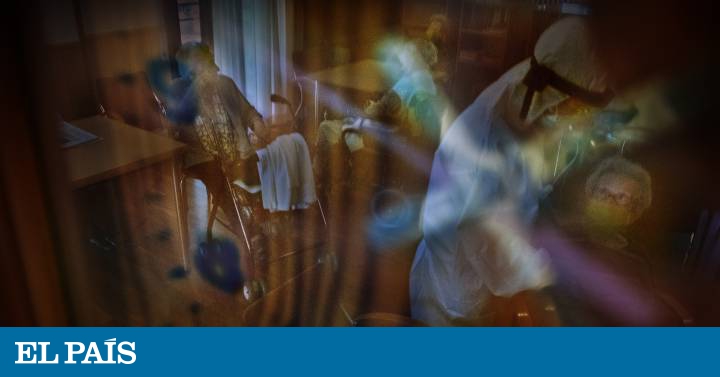This work is the reflection of a look, of an instant of the greatest catastrophe that has devastated the world this century at a global level, and specifically our country since the Civil War (1936-39).
It is a tour of the two main sources of the pandemic in our territory, Madrid and Barcelona;
for its hospitals, nursing homes (the group most punished), funeral homes, cemeteries and for the so-called "new normal."
The official figures, to date more than 32,000 deaths in Spain and more than a million deaths worldwide in less than a year, far outweigh the human losses that may occur in any conflict with conventional weapons.
MORE INFORMATION
The pandemic in Spain without rainbows
Forgotten diseases take the stage
The caregivers
The pandemic caught me in Syria (a country in which at least temperature tests were being carried out in mid-February) and finally, after many difficulties, I was able to return home, finding upon my arrival a feeling of silent death.
In a war there is always destruction associated with death, here it was the opposite, everything seemed to be within normality, except for the absence of people.
Trying to cover the pandemic in Spain was especially difficult because there was a great blockade of the press, especially at the beginning, but that, little by little, could more or less be overcome.
And we were able to take some pictures.
Still, the message that was conveyed in large part was one that was far from reality.
What they achieved with this informational veto was to try to prevent our society from facing the greatest crisis experienced since the Second World War.
Infantilizing the population with messages and images was the worst option, because it meant taking it away from that reality.
Not showing images of victims was part of that kind of Machiavellian game, for which perhaps now we pay the price of not being aware of what happened with discredit and irresponsible or denialist attitudes.
As photojournalists, our responsibility to society was to show the magnitude of the tragedy and to help create a historical memory of what happened for future generations.
But this could not be so, what we have in large part is translated into images of applause and hearts, totally ignoring the most dramatic and real part, the death and slow agony of the more than 32,000 deceased by the pandemic.
Our goal was for that image, that message, to crystallize in the reader's thinking in order to sensitize him from a real perspective, giving him at least the option of answering.
That is our job as photographers.
The reality is that we have more than 32,000 victims and we have no historical memory of how they lived the end of their days
The photographs try to provide information, emotion and composition.
I understand that these are the three keys that an image must have to make a difference, but that is useless without access to information, in this case, the hidden reality.
Our detractors tell us about yellowing and scavenger journalism, and that it is not necessary to teach something that, they say, everyone is aware of.
The answer to this is twofold.
On the one hand, when we talk about the covers of national newspapers that bring us closer to misfortunes or conflicts in distant countries, is that yellow or scavenger journalism?
Those covers or news then would not exist.
We would have no information.
The double standard of the victim is something that is sadly too ingrained in our societies.
Our problem is the relationship we establish with death, we try to hide it, to ignore it, when it is close, and that does not allow us to mature as a society.
Regarding the second answer.
How can we imagine something that we have not seen, and that it corresponds faithfully to reality?
Like it or not, that drama existed, and the ostrich technique is simply a trap that solves nothing.
The reality is that we have more than 32,000 victims and we have no historical memory of how they experienced the end of their days.
Let's imagine the Spanish Civil War without such images or testimonies.
What happened would only be words blurred over time.
We are now experiencing a second wave of covid-19.
And various health sources remind us that this is only the beginning of the road
Ricardo García Vilanova
has carried out this work with the support of the European Journalism Center within the program called Covid-19 Emergency Support Fund.
More information at www.ricardogarciavilanova.com and on his Instagram #ricardogarciavilanova
You can follow PLANETA FUTURO on Twitter and Facebook and Instagram, and subscribe to our
newsletter
here
.

